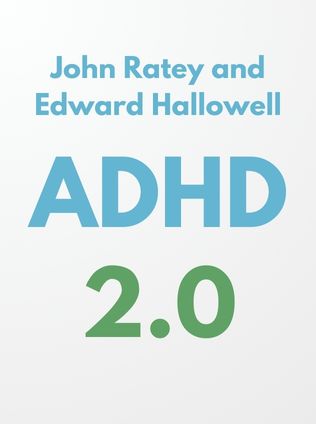
ADHD 2.0
New Science and Essential Strategies for Thriving with Distraction—From Childhood Through Adulthood
By John Ratey and Edward Hallowell
Published 01/2021
About the Author
Edward Hallowell is a psychiatrist specializing in ADHD and the founder of the Hallowell ADHD Centers, which offer diagnostic and treatment services for ADHD and related conditions. John Ratey is an associate clinical professor of psychiatry at Harvard Medical School. Both authors have ADHD themselves, allowing them to add personal insights to their professional training. They coauthored the Distraction series of books, starting with Driven to Distraction in 1992, which explores ADHD as a different way of thinking with its own strengths and advantages.
Main Idea
In ADHD 2.0, Edward Hallowell and John Ratey explain the neurological basis of ADHD and its symptoms. They argue that people can succeed and thrive because of—not in spite of—having ADHD. The book offers strategies to manage ADHD symptoms and leverage its unique traits to the individual's advantage.
Table of Contents
- Introduction: Understanding ADHD
- Chapter 1: The Neurology of ADHD
- Chapter 2: Challenges of ADHD
- Chapter 3: Strengths of ADHD
- Chapter 4: ADHD and Social Connections
- Chapter 5: Creating an ADHD-friendly Lifestyle
- Thriving with ADHD
Introduction: Understanding ADHD
The authors introduce ADHD as a neurological condition affecting 5% to 10% of the population. They describe ADHD as a different way of thinking, not just a disorder. They aim to help readers understand ADHD's causes, symptoms, and how to manage its challenges while harnessing its strengths.
Chapter 1: The Neurology of ADHD
Hallowell and Ratey explain that ADHD results from an underdeveloped cerebellum and deficiencies in neurotransmitters like dopamine and norepinephrine. These neurological differences affect learning, emotional regulation, and quick decision-making. The cerebellum, responsible for skills, emotions, and quick decisions, is less developed in people with ADHD. Moreover, deficiencies in dopamine (associated with motivation) and norepinephrine (associated with concentration) further complicate the condition.
"ADHD results from having a brain that works differently from those of neurotypical people." - Hallowell and Ratey
The authors also introduce the concept of VAST (Variable Attention Stimulus Trait), which describes how modern society's constant bombardment of stimuli can mimic ADHD symptoms in people without the condition. VAST occurs because of the overwhelming amount of information and stimulation from modern technology, leading to ADHD-like symptoms such as an inability to focus and compulsive behaviors.
"The relentless pace and complexity of modern life can create a condition that mimics ADHD in the general population." - Hallowell and Ratey
Chapter 2: Challenges of ADHD
Hallowell and Ratey delve into the specific challenges faced by individuals with ADHD, explaining how these obstacles can significantly impact daily life and overall well-being.
Inattentiveness
People with ADHD often struggle to stay on task and get bored easily. This mental restlessness can manifest as physical restlessness, especially in men. They might appear to be daydreaming or zoning out during conversations or important tasks, making it difficult to maintain focus on one thing for a prolonged period.
- Constantly bouncing legs or drumming fingers during meetings, making it hard to stay attentive and engaged.
"The inability to sustain attention can be a significant barrier to achieving personal and professional goals." - Hallowell and Ratey
Impulsivity
People with ADHD tend to make hasty decisions without thinking them through and struggle with delayed gratification. This impulsivity can lead to problems in various areas of life, including work, relationships, and personal health. The need for immediate rewards often overshadows the ability to plan for long-term benefits.
Sign up for FREE and get access to 1,400+ books summaries.
You May Also Like
The Subtle Art of Not Giving a F*ck
A Counterintuitive Approach to Living a Good Life
By Mark MansonRich Dad Poor Dad
What the Rich Teach Their Kids About Money - That the Poor and Middle Class Do Not!
By Robert T. KiyosakiHow To Win Friends and Influence People
The All-Time Classic Manual Of People Skills
By Dale CarnegieFreakonomics
A Rogue Economist Explores the Hidden Side of Everything
By Steven D. Levitt and Stephen J. Dubner



















